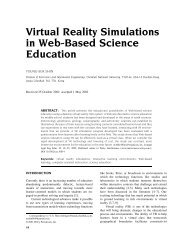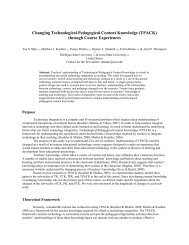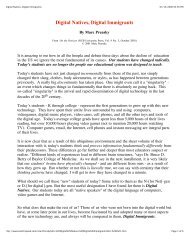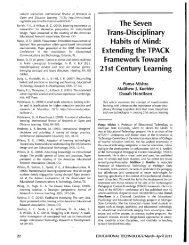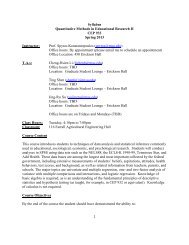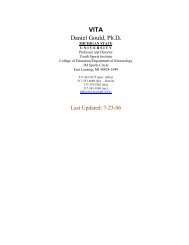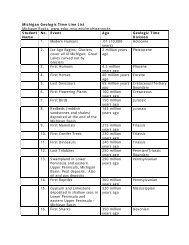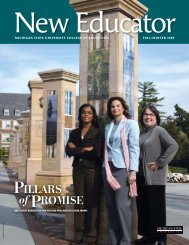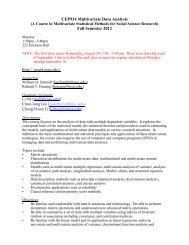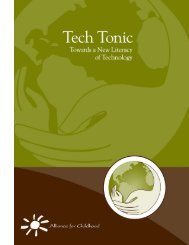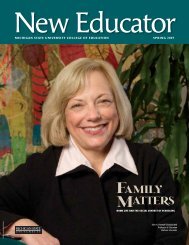Differentiating instruction to include all students. - Michigan State ...
Differentiating instruction to include all students. - Michigan State ...
Differentiating instruction to include all students. - Michigan State ...
You also want an ePaper? Increase the reach of your titles
YUMPU automatically turns print PDFs into web optimized ePapers that Google loves.
Spring 2007 Anderson 51<br />
<strong>Differentiating</strong> the performance measure or product component<br />
of a lesson means affording <strong>students</strong> various ways of<br />
demonstrating what they have learned from the lesson or<br />
unit of study. Differentiation of assessments or products<br />
may be constructed in various ways by the teacher such as<br />
using choice boards (with predetermined options), or the<br />
use of open-ended lists of potential product options from<br />
which <strong>students</strong>’ select or contract for their final product.<br />
The purpose of the product (regardless of its format) is for<br />
<strong>students</strong> <strong>to</strong> rec<strong>all</strong> what they have learned in the lesson or<br />
unit. Differentiated products ch<strong>all</strong>enge <strong>students</strong> at <strong>all</strong> levels<br />
<strong>to</strong> make decisions, be responsible for their own learning, as<br />
well as affording them opportunities <strong>to</strong> demonstrate what<br />
they know through products that are representative of their<br />
unique learning preferences, interests, and strengths.<br />
In Mr. Wright’s classroom, products differentiated on the<br />
basis of <strong>students</strong>’ interests may mean that Amanda and<br />
Roger work <strong>to</strong>gether on demonstrating what they have<br />
learned about their state’s geography, whereas Jacob, Reno,<br />
and others may work as a sm<strong>all</strong> team <strong>to</strong> present on the main<br />
industry of the region. All <strong>students</strong> can work <strong>to</strong>ward demonstrating<br />
what they have learned through varying representations<br />
on the basis of their unique interests. Each individual<br />
is assessed using established criteria (typic<strong>all</strong>y, a rubric) by<br />
the teacher assessing <strong>students</strong>’ mastery of the knowledge<br />
and skills outlined within the lesson or unit. This approach<br />
<strong>to</strong> assessing <strong>students</strong>’ knowledge not only yields reliable<br />
assessment of their knowledge and skills but also provides<br />
evidence of each individual’s value <strong>to</strong> the learning process<br />
within the classroom.<br />
Getting Started<br />
For Mr. Wright, starting differentiation may begin with<br />
the creation of learning profiles; simple profiles of each student<br />
containing pertinent information specific <strong>to</strong> learning<br />
preferences, family structure, favorite hobbies and interests,<br />
and other aspects of interest. Each profile may also contain<br />
specific grade-level information for each child such as state<br />
assessment scores, Lexile reading scores, and fluency<br />
recordings. These individual student profiles are central <strong>to</strong> a<br />
teacher’s inspiration in planning engaging, student-centered<br />
differentiated lessons and <strong>instruction</strong>al activities. Mr.<br />
Wright will use individual student profiles <strong>to</strong> plan flexible<br />
groupings and build tiered lessons that address the unique<br />
talents and abilities of Reno, Amanda, Jacob, and Roger<br />
without sacrificing rigorous curriculum standards and performance<br />
expectations.<br />
Mr. Wright may choose <strong>to</strong> start off by introducing his <strong>students</strong><br />
<strong>to</strong> differentiated <strong>instruction</strong> by modifying the process<br />
of a few lessons. For example, he may create a “choice<br />
board” from which his <strong>students</strong> can select activities he has<br />
carefully constructed on the basis of his knowledge of their<br />
readiness levels in reading (see Appendix A). By developing<br />
a choice board, Mr. Wright has provided his <strong>students</strong><br />
with important options, flexibility in how they demonstrate<br />
the knowledge and skills they have learned after direct<br />
<strong>instruction</strong> has occurred, as well as affording them the<br />
opportunity <strong>to</strong> make decisions and actively participate in<br />
their own learning. Every child has a choice board with only<br />
Mr. Wright knowing the differing levels of the activities<br />
from which the <strong>students</strong> have <strong>to</strong> choose. Every student will<br />
complete two out of the six activity options and each individual<br />
will have demonstrated skill <strong>to</strong>ward the objective of<br />
the lesson; only they will have taken varying paths of “how”<br />
they demonstrated their performance.<br />
Next, Mr. Wright may decide <strong>to</strong> introduce differentiated<br />
projects <strong>to</strong> his <strong>students</strong>. For example, at the conclusion of a<br />
social studies unit on regions of the state of North Carolina,<br />
Mr. Wright may provide his <strong>students</strong> with a list of possible<br />
projects from which <strong>students</strong> must decide how <strong>to</strong> best<br />
demonstrate their newfound knowledge and skills (see<br />
Appendix B). Students may choose <strong>to</strong> work in pairs, sm<strong>all</strong><br />
groups, or individu<strong>all</strong>y. Mr. Wright’s responsibility in planning<br />
the differentiated product selections is <strong>to</strong> <strong>include</strong> possible<br />
project options that afford every student an opportunity<br />
<strong>to</strong> be successful in demonstrating knowledge and skills.<br />
Some of the options created by Mr. Wright will require <strong>students</strong><br />
<strong>to</strong> receive some guidance and direct <strong>instruction</strong> from<br />
him, whereas other selections may release the student(s) <strong>to</strong><br />
work independently only requiring teacher assistance when<br />
needed or requested. Some <strong>students</strong> may create their own<br />
timeline for completion of their projects depending on their<br />
abilities <strong>to</strong> do so, whereas others may require direction and<br />
more frequent moni<strong>to</strong>ring by Mr. Wright. What is important<br />
is that Mr. Wright’s <strong>students</strong> are not only achieving the curricular<br />
performance benchmarks, but they are exploring,<br />
creating, making decisions, and playing an important role in<br />
their own learning process.<br />
Taking the First Step<br />
Mr. Wright surrendered his ideals <strong>to</strong>ward teaching <strong>to</strong> the<br />
needs and talents of <strong>all</strong> of his <strong>students</strong> (much like many<br />
teachers) because of increased pressures in meeting benchmark<br />
proficiency standards and student performance expectations.<br />
Can he justify using differentiated approaches <strong>to</strong><br />
learning within the framework of accountability? Some<br />
individuals in the field of education continue <strong>to</strong> question<br />
whether differentiated <strong>instruction</strong> can withstand rigorous<br />
accountability standards and high-stakes testing. More and<br />
more research is beginning <strong>to</strong> emerge within the field of<br />
education supporting the potential for differentiated <strong>instruction</strong><br />
as a vital means of assisting diverse learners in their<br />
acquisition of knowledge and skills while also breaking<br />
down the barriers that inhibit their unique abilities <strong>to</strong> successfully<br />
demonstrate their maximum potential as learners<br />
(cf. Baumgartner, Lipowski, & Rush, 2003).



